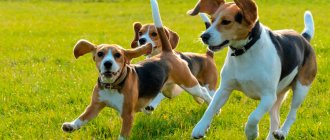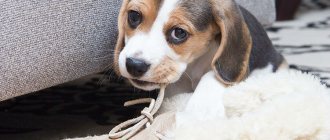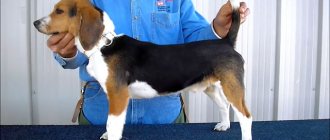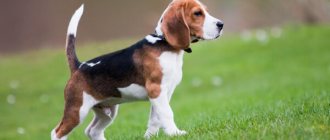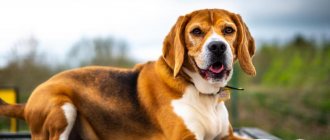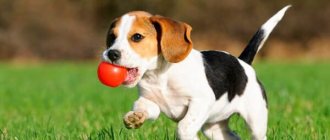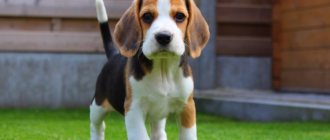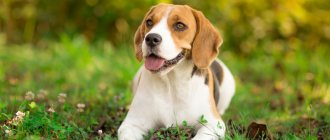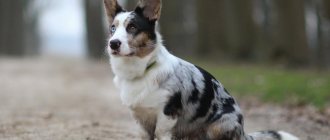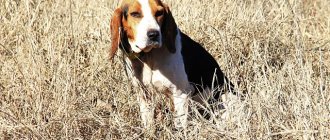The Beagle dog is a popular breed of British origin, distinguished by its good nature and mobility. These restless pets never sit still and never refuse to play. However, behind the external simplicity lies a complex and independent personality, to whom you need to find a special approach. Let's find out what standards beagles must meet and how to deal with such a dog.
Beagle dog: a brief history of the breed
The origin of the Beagle breed is the subject of much debate. Some believe that these dogs originated in Ancient Greece. According to another version, hounds developed in the British Isles. Their ancestors are considered to be large foxhounds, used for hunting hares.
Despite the fact that the exact origin of the Beagle breed remains a mystery, the official homeland of the animals is still recognized as Great Britain. Compact hounds gained unprecedented popularity during the reign of King Edward II, but over time they were almost forgotten. The history of beagles received a new twist in the 19th century, when a number of experiments were carried out to improve the dogs' exterior.
Chocolate tricolor
Among the “liver” tricolor colors, the black gene will produce brown. Chocolate beagles have gray-green eyes, and the nose, lips and eyelids are brown, and their shades can be different: dark chocolate, light brown, liver, lilac.
This color was not recognized by the British Kennel Club and the FCI. If such puppies are born, they are considered a breeding match. But, for example, in the USA, chocolate beagles are officially registered and show the highest results in the rings.
Chocolate puppies with gray-green eyes may become darker with age and their eyes may become hazel. It also happens that a lilac dog, in addition to the weakening brown, also has blue, and then the fur acquires a bluish tint.
Breed description, standards and appearance
The Beagle dog looks strong and self-confident; it is a small but strong hound, perfectly adapted to perform its direct duties. She moves freely and elastically, swinging her front legs well and pushing powerfully with her hind legs. To waste less energy, the animal lifts its paws off the ground as little as possible.
In the Beagle dog standard, the height at the withers is indicated in the form of the minimum and maximum permissible values - 33 cm and 40 cm. Animals are not disqualified for deviations in height, but the score is reduced.
The weight of a beagle is 14-18 kg. The pet should not be fat or emaciated - all aspects are in complete harmony.
On a note. The weight of an adult girl dog will be slightly less than that of a boy beagle.
Description of the beagle dog standard ICF No. 161:
- The head is proportional to the body, strong, but at the same time graceful. Divided by a stop approximately in half. The skull is convex and wide. The muzzle is shaped like a blunt wedge.
- The jaws are strong and have a scissor bite.
- The eyes are brown or hazel, rather large, set wide apart.
- Beagle ears are drooping and have rounded tips. If you pull them forward, they will reach your nose.
- The neck is slightly arched. With its help, the animal can easily reach the ground with its nose. There is a small suspension.
- The body is perfectly balanced and designed for long runs. The back is level, the loin is short and strong. In a Beagle dog, the chest size is proportional to the length of the limbs. The belly is not dry, but not saggy either.
- The tail is thick and of medium length. Sits high and gives the dog a perky look. The animal never twists it into a ring or throws it on its back.
- The limbs are straight, placed strictly vertically under the body. The length of the paws to the elbows is approximately equal to ½ the height.
Beagle dog – color
According to the official description of the breed, the body of Beagle dogs is covered with short and dense hair that protects from cold and rain. The most common color is the so-called tricolor, when the body is painted black, red and white.
There is a blue beagle, a combination of red, white and blue. It is more correct to call such animals gray, since the color weakening gene gives the unusual shade. The blue beagle has light eyes and an almost gray nose. In puppyhood, these are the only signs by which dogs are distinguished from the standard tricolor.
The pet can also be two-colored - the suit is called bicolor. In this case, red, red or lemon markings are scattered on a white background. A less common species is the black and white beagle.
Variegated dogs are also popular in the UK:
- motley badger;
- hare-motley;
- lemon-variegated.
The only solid color allowed is white. With the exception of it, all other suits can have specks.
Solid colors
The breed standard allows two or three colors, sometimes one solid color is found. Only the white beagle is officially recognized, which is considered to be the result of a genetic trait. The only one-color color allowed by the standard is a rather rare specimen. It is unacceptable for such a dog to have markings. There are no completely black beagles.
There are many color variations of hounds; it is impossible to single out one “correct”, “canonical” color. It’s not for nothing that a saying has taken root among breeders, dog handlers and professional huntsmen: “No good hound can be a bad color” - not a single good dog will have a bad color. Experienced dog breeders first of all pay attention to the health and working qualities of the dog, and only then evaluate the external characteristics.
The main thing is that all representatives of the considered breed are united by the excellent qualities of a real hunter, friendliness, cheerfulness and lack of conflict, devotion and a sharp, inquisitive mind. These dogs are attached to their owner and are excellent companions.
Beagle breed varieties
According to the AKC classification, Beagle dogs are divided into 2 types:
- The English Beagle is a true representative of the breed. It has compact dimensions: height up to 40 cm, weight up to 17 kg.
- The American Beagle is the result of the work of breeders from the USA. These are tall and muscular dogs, growing up to 55 cm at the withers and weighing up to 27 kg.
As a result of breeding work, several more types of beagles were developed, which are separate breeds:
- The French Beagle Harrier is a cross between beagles and harriers that was bred in France in the 19th century. Height ranges from 38 to 48 cm, weight reaches 20 kg.
- The European Beagle is light and compact. It is smaller in size than its American counterpart, but remains an excellent hunter and companion.
- The Kerry Beagle is a breed of Irish origin that dates back to the 16th century. Weighs from 20 to 27 kg, height is about 45–55 cm.
An unrecognized variety is the dwarf or mini beagle. Such dogs were popular during the reigns of Henry I and Elizabeth I - their height did not reach 20 cm. Through the efforts of breeders, the breed increased in size, but “pocket” puppies are still born.
Another charming dog that is closely related to the breed in question is the Beagle Basset Hound. This is a mix of beagle and basset hound, which was developed in France in the 19th century. The average weight is 15 kg, height ranges from 30 to 42 cm.
Fans confuse the breed with another hound – the Basset Hound. They have common ancestors, but a professional will immediately notice that the dogs are practically not alike. External differences between beagles and basset dogs are visible to the naked eye. The latter are squat and elongated, with characteristic sad eyes and long ears. They are not so active, more phlegmatic and calm.
The Beagle Basset combines features of both breeds. It has a square muzzle, bulging eyes, short legs and an elongated body. However, he is more active than the classic basset hound and is suitable for jogging or cycling. He is good with children, and with proper upbringing, he even gets along with cats.
This is interesting. Breeders and hobbyists continue to experiment. For example, a Beagler is a dog obtained from the mating of a Beagle and a Cavalier King Charles Spaniel.
Tricolor
Black, red and white beagles are more common than other colors. Their puppies are black and white at birth (there may be brown markings around the ears and eyes), with red appearing as the puppies grow. Black can be bright throughout life, or it can fade and become paler. Red ranges from red to fawn. The white is always pure white, although in speckled dogs it is closer to cream. The tip of the nose and the rim of the eyelids are black.
Sometimes puppies of this color variety, after reaching 6-8 weeks, develop white hairs on their black backs - “overhairs”. They usually disappear after some time.
Beagle dog - character and behavior
Beagle dogs never get discouraged and never let their owners get bored. They are not characterized by aggression or cowardice - breeders discard animals with obvious defects.
The Beagle is an intelligent dog, but due to its innate stubbornness, it can be quite difficult to train. But if you show yourself as a leader and at the same time show patience, the pet will turn into a loyal friend who loves its owner with all his soul.
On a note. The peculiarity of the Beagle breed is its loud bark. Therefore, owners need to prepare for possible complaints from neighbors.
Beagles exhibit a hunting instinct towards rodents and other small pets. Therefore, the animal cannot be kept in the same apartment with rabbits, chinchillas and decorative rats.
On a note. The little hound cannot stand being alone. A day spent within four walls would be the worst punishment for her.
If there is a lack of upbringing, the beagle develops bad habits - he plays pranks, chews things and furniture, and refuses to follow commands. Undesirable behavior must be corrected immediately, otherwise the pet will become completely uncontrollable.
Beagle and children
The Beagle dog is friendly and patient; it will never offend younger family members if they do not cross the boundaries of what is permitted. She herself resembles a mischievous child. This is probably why it is so easy for a pet to find a common language with children. The dog happily plays the role of a caring nanny.
For an introverted child, he will become a tailed psychologist - thanks to regular communication with a cheerful dog, kids become more relaxed and develop faster. At the same time, the dog guards and protects the small members of the “pack” - if the children are in danger, the beagle will immediately come to their defense.
Watchdog and security qualities
The Beagle breed has poorly developed guard qualities - the dog initially considers all people to be friends. However, the pet will greet strangers with loud barking. But this is not a threat, but a joyful greeting, so there is no need to hope that the dog will become an excellent watchman.
It is still possible to reveal the security and watchdog potential of an animal - it is taught to give a voice when strangers approach. In some cases, this is enough to scare off an intruder who is not aware of the dog's innate good nature.
Thanks to their keen sense of smell, beagles serve in the police and customs, where they search for drugs and explosives.
Expert opinion
Leonid Rodin
Experienced dog breeder
Ask a Question
The beagle's unusually keen sense of smell allowed him to master some “side” professions. For example, French and British hoteliers use the skills of these hunting dogs to find... bedbugs. Bloodhounds easily detect even isolated cases of blood-sucking creatures entering hotel premises, signaling the discovery with a joyful bark. Thanks to this, owners carry out timely disinfection, preventing parasites from spreading over a large area. And the US Department of Homeland Security entrusted the Beagle team with checking passengers' luggage to detect illegally imported food products. Along with them, all kinds of pests also penetrate into the country, which hunting dogs can smell a mile away. But there are also more exotic examples of the application of a unique natural sense of smell in practice. In the city of Denver (USA), the beagle Elvis is engaged in determining the onset of pregnancy in female polar bears using feces. During a visual examination, ministers are not able to identify this fact in the early stages or distinguish a false pregnancy from a true one. The dog's nose copes with the task correctly in 97% of cases. These are the professions that their fantastic instincts have led beagles into.
Brown
Almost all cynological organizations, when describing the Beagle, require the presence of a white color. However, there are individuals without this shade. American and Canadian conformation does not require the breed to have a white color (and the same tip of the tail). Professional hunters in the United States can find bicolor Beagles, which have a dominant red or brown tone.
The complete absence of white color often raises doubts among experienced dog breeders. They suspect such Beagles of being unclean and believe that the dogs have been infused with the blood of other breeds. This theory has a place to be, since hunters do not focus on the exterior and focus on the hunting qualities of the dog.
Hunting with a beagle
Beagles have well-developed hunting instincts. A keen sense of smell allows you to sense prey at a great distance. The animal is completely immersed in work, without being distracted by extraneous stimuli.
Beagles can hunt a wide variety of game:
- hares;
- ducks;
- wood grouse;
- woodcocks;
- black grouse, etc.
If desired, the pet can be trained to hunt a beaver, roe deer, deer or wild boar. However, the dog may have its own preferences. If she flatly refuses to take a certain game, it is better not to force it, but to find another use for it.
When hunting, the beagle is very persistent - he pursues the victim to the bitter end, until the hunter kills it. Compact size and light weight allow the animal to easily move through deep snow. And on the crust the pet actually runs as if on asphalt.
A beagle puppy must undergo training. At first it is better for him to work in a group where there are experienced hunting dogs. Looking at his older comrades, the teenager will quickly understand what is required of him.
Bicolor
The color can also be called red and white. The two-tone color is expressed by red shades of pigment and white. In turn, red tones, depending on their saturation, can be called red, red or lemon. At birth, Beagle puppies have cream or fawn markings, which darken as they grow. "Schisandra" are almost white, their nose is dark.
Light red and white color - lighter than true red and white. Often these puppies darken with age. Bicolors can grow red-and-white, or they can grow lemon-white.
The pigment of the nose is usually darker in light-colored dogs. The initially light lobe may darken with age, and its color in females also changes depending on the hormonal period.
How to choose a beagle puppy
Pedigree Beagle puppies are sold in large nurseries registered with the RKF/FCI. Sick babies or mixed breeds are often sold by hand. Before purchasing, you should study reviews and consult with current owners. Perhaps one of them will recommend a trusted breeder.
Arriving at the nursery, the first thing you need to do is inspect the litter and meet the parents. Many diseases, like temperament defects, are inherited. Beagle puppies must be well-groomed and kept in clean enclosures, free of dirt and excrement.
A responsible breeder will tell you everything about the Beagle breed: he will point out not only its advantages, but also its disadvantages. He will definitely take an interest in the future fate of the baby and give valuable advice regarding maintenance and care. In the future, you can contact him if problems arise with your pet.
Important. Beagle puppies must have a veterinary passport with vaccination records and a birth certificate.
Puppies
A newborn beagle weighs 250-450 g. The puppies are still absolutely helpless. But in the first month they are completely transformed - they stand on their feet, open their eyes, and show genuine interest in the world around them.
During the period of active growth, dogs especially need balanced food. The little beagle, which is not yet a month old, feeds exclusively on its mother's milk. Then they begin to introduce complementary foods. At this time, food is given 6 times a day at regular intervals.
Gradually new products are introduced into the diet:
- Beagle: 2 months - the baby is fed the same way as the breeder did. As a rule, he is given finely chopped beef, vegetable purees, cottage cheese and milk.
- Beagle: 3 months – puppies are given porridge (oatmeal, buckwheat, rice). The meat is cut into larger pieces so that the pet can chew them easily. As they grow older, they include offal. The number of feedings is reduced to 5.
- Beagle: 6 months – It is useful for puppies to gnaw on marrow bones while changing their teeth. A couple of times a week they prepare porridge with sea fish, and continue to give them fermented milk products to replenish calcium reserves in the body. In consultation with the veterinarian, vitamin and mineral complexes are selected. Feeding frequency – 4 times a day.
From six months to a year, the animal is fed 3 times a day, the diet is as close as possible to that of an adult. The puppy should look moderately well-fed, but not fat. An adult beagle eats 2 times a day. Using the table below, you can track the correct development of your beagle dog by month.
| Age | Height | Weight |
| 1 month | 18-20 cm | 1.5-2 kg |
| 2 months | 22-25 cm | 3-4 kg |
| 3 months | 28-30 cm | 5-6 kg |
| 4 months | 30-32 cm | 7-8 kg |
| 5 months | 32-34 cm | 8-10 kg |
| 6 months | 33-35 cm | 9-11 kg |
| 7 months | 35-37 cm | 11-13 kg |
| 8 months | 36-37.3 cm | 12-14 kg |
| 9 months | 36.4-37.5 cm | 13-15 kg |
| 10 months | 37-38 cm | 14-16 kg |
| 11 months | 38-39 cm | 15-17 kg |
| 12 months | 38-40 cm | 16-18 kg |
Growing up passes very quickly - within a year the beagle grows to the size of an adult dog.
Mating
Owners should be ready for the female beagle to reach puberty at the age of 7-10 months. This will be indicated by blood discharge and a swollen genital loop. But readiness to conceive occurs only after the dog has fully matured, or rather at one and a half to two years. Estrus will last 19-23 days with a frequency of 3-6 months .
You should approach the selection of a pair for mating with responsibility and ask the breeder for advice. He will tell you how to choose a healthy dog with the “correct” characteristics. It is worth noting that mating will be more successful if at least one of the partners is experienced.
- Having made your choice, it is worth creating the conditions for getting to know each other. It is best to do this on neutral territory, in a park, on a playground. But the place should not be too crowded and noisy. The dogs must sniff each other and accept.
- If the result is positive, a mating date can be set. It should fall for a period that lasts a week after the 10-15th day of estrus. The place of the meeting is not particularly important; mating can be carried out both on the territory of the girl and on the territory of the boy. The main thing is that the meeting takes place in the morning and no one disturbs them. You need to repeat the procedure in about a day.
- Pregnancy can sometimes be difficult, and there is a risk of giving birth to weak and premature puppies. Beagles usually become parents of 5-6 puppies .
Beagle dog - care and maintenance
Beagles are working dogs, so they are very unpretentious. Care consists of timely hygiene procedures, proper feeding and education.
For more information on how to properly maintain the breed, read the article “Beagle in an apartment.”
The right diet
Hounds can be fed both natural food and industrial feed. Many dog breeders choose the second option because it saves time, eliminates the need to carefully select products and introduce vitamin complexes into the diet.
Animals are bought high-quality super-premium or holistic products intended for active breeds. With natural nutrition, the menu includes:
- lean meats and offal (70%);
- porridge (25%);
- vegetables (5%).
Periodically, dogs are given sea fish, dairy products, eggs and fresh herbs. Fruits play the role of treats.
Also read: “The correct diet for feeding a beagle.”
Walking and physical activity
The Beagle is a hound breed, so it cannot live without movement. The dog needs to regularly throw out the accumulated energy, otherwise it will upset the whole house. On the street, the pet should frolic to its heart's content - it is advisable to let it off the leash. It is better to do it in places where there are no cars or other animals.
Your pet will be happy to go into nature - to the forest or to the river bank. Here he will find many new smells and sounds, as well as the pursuit of birds and small animals. The dog should not be let out of sight: having felt freedom, it stops obeying, which is why it can get lost.
On a note. Dogs are walked 2-3 times a day for at least 40 minutes.
Beagle dog - training and education
Hounds have a freedom-loving and willful character, so they need to be trained from a very early age. It is advisable that the owner has experience training hunting dogs. Unlike service breeds, they will not obey commands unquestioningly.
The pet is inclined to make decisions independently. First he will think whether the owner’s demand is so important. If the dog considers the order useless, he will quickly put on a mask of complete misunderstanding and stop hearing and seeing everything that is happening around him.
Learn about all the intricacies of beagle training.
The main task is to show the animal that man remains the undisputed leader. To do this, you need to act firmly and patiently. The best motivator is sincere praise and tasty treats. If you use violence and shout, the dog will withdraw into itself and try to do something nasty in response.
If problems arise with training, it is recommended to contact a professional dog trainer. Like all city dogs, it is advisable to undergo OKD to develop basic skills. Don’t forget about timely socialization. Once the Beagle puppy has become comfortable, he is carefully introduced to other people and canines, new sounds and smells. This way he will learn to adequately interact with the world around him.
Important. Due to lack of socialization, dogs grow up nervous, aggressive and hysterical.
Beagle dog hygiene
Short hair is brushed a couple of times a week with a brush or rubber mitt. During seasonal molting, the procedure is carried out more often, using a special device - a furminator.
Bathing is required only if the pet is very dirty. Beagle dogs are washed with hypoallergenic shampoos designed for short-haired animals. Then the pets are thoroughly dried with a towel and left to dry away from drafts.
On a note. After a walk, just wash your paws and wipe your tummy with a damp cloth.
The eyes are inspected daily for the presence of dust and secretions, and if necessary, wiped with cotton wool soaked in an antibacterial solution. Ears are cleaned once every 2 weeks. Claws are shortened as they grow, unless the pet grinds them down on his own. Oral health is maintained with a brush and veterinary paste or dental treats.
Vaccinations and susceptibility to disease
Puppies are vaccinated for the first time at 8-12 weeks. After 21 days, a revaccination may be required - it all depends on the vaccine used. The main dangers are the following diseases:
- plague of carnivores (distemper);
- rabies;
- parainfluenza;
- parvo and coronavirus enteritis;
- hepatitis;
- adenoviral infection;
- leptospirosis.
The veterinarian can adjust the schedule, taking into account the pet’s living conditions and the prevalence of diseases in a certain area. Adult dogs are revaccinated annually and treated against fleas, ticks and worms every 3 months.
The Beagle dog breed boasts good health, but due to its structure, it often has problems with the eyes and ears. She is also susceptible to:
- hip dysplasia;
- epilepsy;
- achondroplasia (bone growth disorder);
- hypothyroidism (decreased thyroid function).
Regular hygiene and annual visits to the veterinarian will help protect your pet from disease.
Can a beagle dog live outside?
A one-room apartment is not the best place to keep an active hound. A private house with a large fenced area is more suitable for Beagles. here he will be able to run, jump and give free rein to his hunting instinct.
In the southern regions, a pet can live on the street all year round, provided that it has a warm kennel. Dense fur protects well from bad weather, but the animal is not able to withstand severe frosts.
The main danger facing a Beagle dog in winter is hypothermia. A pet with a cold instantly weakens its immunity. There is a high chance that he will get sick:
- cold;
- pneumonia;
- arthritis;
- otitis media
Prolonged exposure to cold is fraught with inflammation of skeletal muscles, kidneys and ureters. When walking in winter, your beagle should be dressed in overalls.
Important. Hounds must not be kept in a cage or on a chain. Such conditions are fraught with serious problems with both physical health and mental health.
Lifespan
Hounds live on average 12 years. But with proper care, good heredity and timely vaccinations, representatives of the Beagle dog breed can easily cross the 15-year mark.
Key points in training
These beauties also have a share of cunning; they are rightly called “cute impudents,” which exactly describes their attitude to training. For example, by succumbing to weakness and allowing the puppy to fall asleep in the bed, you can forever instill in him the desire to return there again. Taking advantage of their charm, they will easily win their place in the master's bed; no attempts to drive him out will be successful.
The main thing is to learn to strictly, but without assault, instill respect and obedience in the animal. Such a smart, quick-witted dog can really be taught commands.
It is important to organize early socialization and general training for your beagle at a young age.
- Read about how to properly train a dog in the article: “Training a puppy: effective methods from dog handlers, learning commands at home.”
Beagle dog: pros and cons of the breed
After reading reviews from Beagle dog owners, the pros and cons of the breed become obvious. Hounds are friendly, not prone to dominance, cope well with the role of companions, do not require specific care, and are unpretentious in food.
However, the difficulties of the Beagle breed are its innate stubbornness, self-will and determination. These traits can be corrected, but it is almost impossible to completely get rid of them. The hunting instinct causes certain inconveniences - after chasing a cat or rodent, the pet may get lost.
As can be seen from the description of the breed, the Beagle's shortcomings lie in its character. A hyperactive dog requires long walks and active games. He will not be able to play the role of a sofa dog - the pet vitally needs movement.
| pros | Minuses |
| Friendly character | High activity |
| Good attitude towards children | Frequent escapes on walks |
| Easy care | Tendency to corpulence |
| Devotion to the whole family | Loud barking |
| Excellent hunters, companions and playmates | Requires a special approach to training |
| Good health | Willfulness and stubbornness |
The Beagle is a cheerful and mischievous dog, reminiscent of a small child. With proper upbringing, she will grow up to be a wonderful hunter and a devoted friend who will never let you get bored.
Health, illness
Beagles are hardy dogs with good health, but they are not immune to illness. The most common diseases:
- Hip dysplasia.
- Achondroplasia.
- Dermatitis.
- Allergy.
- Epilepsy.
- Diabetes.
- Hepatitis.
- Glaucoma, cataracts, iris dysplasia.
- Ear infections.
In case of any ailment or manifestation of symptoms of any disease, the dog must be shown to a veterinarian.
To detect the disease in the early stages of development, take your pet to the veterinarian for preventive examinations twice a year.
Regularly deworm your pet and treat it for external parasites.
When changing teeth, give your dog toys that he can chew on.
